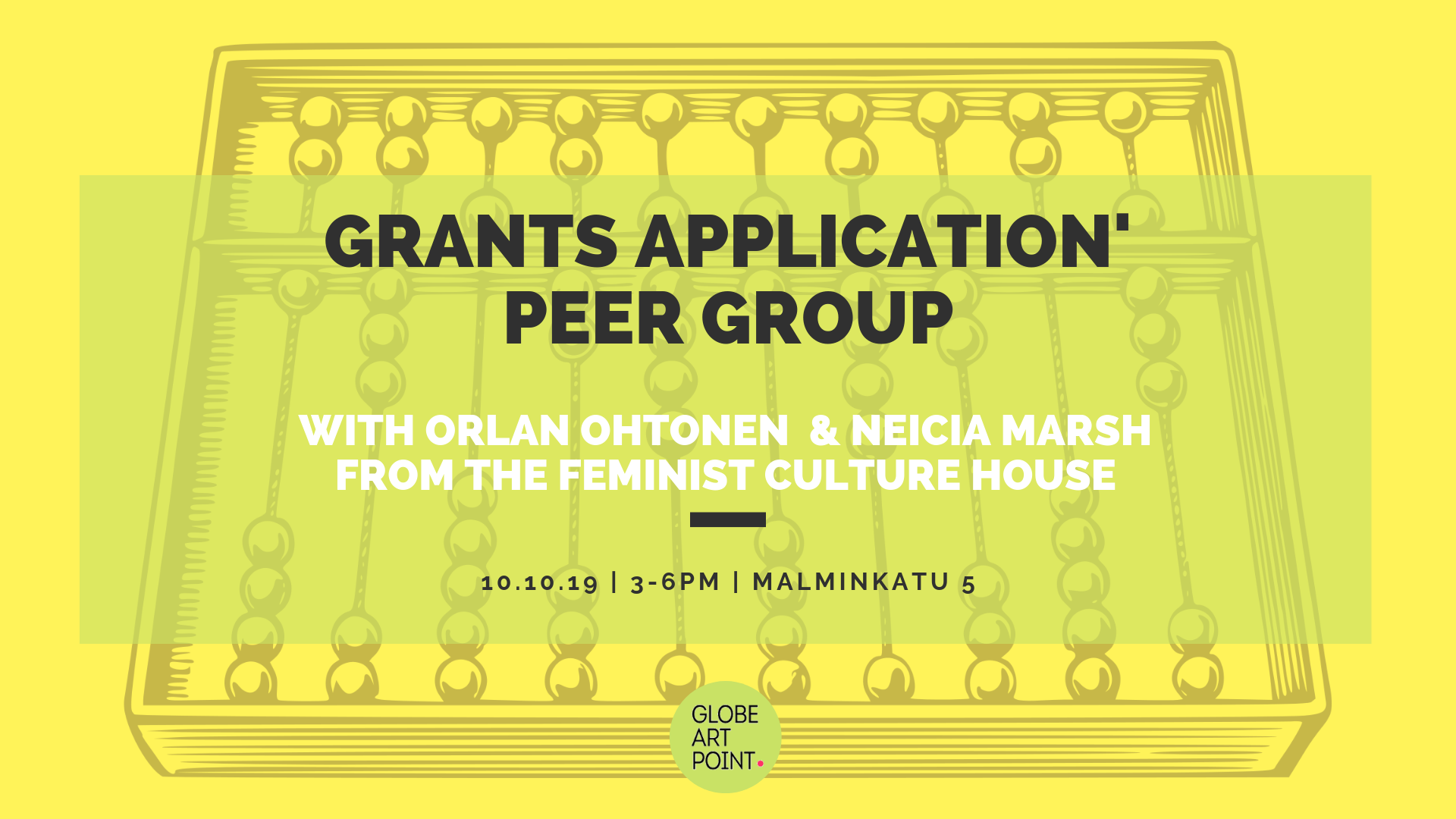Join Orlan Ohtonen & Neicia Marsh from the Feminist Culture House* to discuss your Taike / SKR applications, including respectful budgeting, working conditions, and valuing labour within your grant applications.
Bring along a burning question related to your application’s working plan or budget
See examples of successful applications (focus: contemporary art, exhibitions, projects, events)
Plan to dream equitable working conditions within the arts field
The maximum number of participants: 15 people.
Enrol by writing an email to info(at)globeartpoint.fi telling us about your grant application’ project or/and main problem with it.
Priority to non-Finnish born artists and culture workers residing in Finland.
Place: Malminkatu 5, map
Date and time: 10th October, from 3 pm to 6 pm
Language: English (and Finnish if needed)
Registration deadline: 3rd October 2019, noon 12.00 am
NOTE: ALL REGISTRATIONS WILL BE SELECTED ON 3.10.19 AND CONFIRMED BY 4.10.19 MORNING.
*Feminist Culture House (FCH) is an artistic research project led by a curatorial collective. It functions as a peer-led supportive structure for those who are practicing in the Finnish art field, but due to—for example, structural racism and cis-sexism—have to work harder to be recognised. FCH creates a caring and inclusive feminist working community based on sharing, togetherness, celebrating, and supporting one’s peers.
ACCESSIBILITY
The office which is located in Malminkatu 5, Kamppi, Helsinki. Our facilities are accessible on the street level, assistant dogs are welcome, there is no accessible toilet in the space office.
ETHICAL RULES FOR USING G.A.P.’S FACILITIES
No one should make assumptions of or question someone’s background, gender or experiences.
Every person inside the facilities must be treated equally and respectfully. Discrimination and any kind of harassment, sexual or otherwise, are strictly forbidden. This includes language. It also condemned the use of discriminatory, subordinating, repressive or offensive terminology (different slurs and invectives), not even in examples or to describe something.
By using the G.A.P.’s facilities you commit yourself to be responsible for your behaviour and to follow these rules. The workers, members and facilitators of events inside G.A.P. are responsible for securing that every participant and guest are aware of them.
In conflict situations, the organiser of events as the team of G.A.P. has the right to intervene. If you witnessed or experience any harassment inside G.A.P., please inform immediately to the team or to the event facilitator.
What is discrimination?
A simple definition of discrimination is that a person is treated unfavourably, or someone’s character is defamed in a way that is connected to at least one of the following grounds:
gender
transgender identity or non-normative gender expression
cultural or ethnic background
religion or other conviction
functional ability
sexual orientation
age
nationality
origin
language
appearance
Discrimination can be direct or indirect. Inadequate accessibility, harassment (sexual or otherwise) and instigation of discriminatory practices are also types of discrimination.
What is harassment/sexual harassment?
Everyone has the right to not be sexually harassed while they’re working, regardless of whether the harasser is a facilitator, employer, colleague, guest or another content producer. Harassment is an action that offends a person’s honour and is tied to one or more of the grounds of discrimination mentioned above.
Harassment can be holding someone up to ridicule, or demeaning generalisations that are connected to grounds of discrimination. Harassment can also by nature be sexual. In addition to comments and words, this can include unwanted touching, meaningful glances, groping, jokes, suggestions and sexual images. It can include sexually-toned language. It can also include unwanted compliments, invitations or innuendos. Sexual harassment differs from normal flirting in that the former is unwanted. The target of harassment determines whether or not the behaviour is offensive and defamatory.
